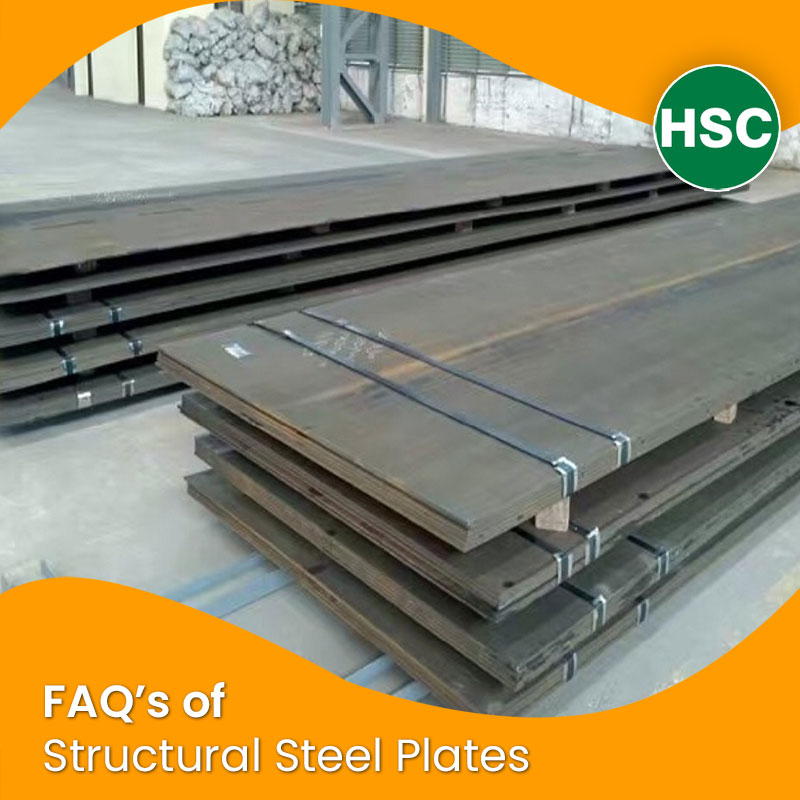What Are Structural Steel Plates Used For?
Structural steel plates are flat-rolled steel sheets specifically engineered to provide high strength, ductility, and weldability for load-bearing, fabricated, and structural applications. These plates are widely used in the construction of buildings, bridges, towers, ships, and industrial plants where structural integrity is critical.
At Hindustan Steel Corporation, we supply IS 2062, ASTM A36, EN 10025 S275/S355, and SAILMA grades in cut-to-size, ready-to-fabricate condition—helping our buyers in civil, mechanical, and offshore industries.
Common Applications of Structural Steel Plates Across Industries
Structural steel plates are used in:
- Building Construction: Columns, beams, trusses, and floor systems
- Bridge Engineering: Girders, decks, stiffeners, and diaphragms
- Warehouses & PEBs: Shed columns, rafters, bracing
- Industrial Fabrication: Machinery frames, pressure components, base plates
- Shipbuilding & Marine: Hulls, decks, bulkheads
- Power Plants: Support structures, turbine platforms
- Telecom & Transmission Towers: Lattice arms, tower legs
- Road & Metro Projects: Retaining walls, formwork, crash barriers
Structural vs Boiler vs High Tensile Plates – What’s the Difference?
| Plate Type | Strength | Usage |
|---|---|---|
| Structural Plate | Medium-High | Buildings, bridges, towers |
| Boiler Plate | Moderate | Pressure vessels, tanks, steam lines |
| High Tensile Plate | Very High | Cranes, trailers, off-road structures |
Structural plates prioritize formability + strength while maintaining cost-efficiency.
Typical Mechanical & Chemical Properties of Structural Steel Plates
| Property | Typical Range |
|---|---|
| Yield Strength | 250–450 MPa (varies by grade) |
| Tensile Strength | 410–700 MPa |
| Elongation | 20–28% |
| Carbon Content | 0.2–0.25% |
| Weldability | Excellent (Low carbon) |
Grades like IS 2062 E250/E350, S355J2, and A36 offer balanced strength and ductility for most steel frameworks.
Most Popular Structural Steel Grades We Supply
- IS 2062 Grade A, E250, E350, E450
- SAILMA E250–E650
- EN 10025 S235JR, S275JR, S355J2
- ASTM A36, A572 Grade 50
- JIS SS400
- DIN St37-2, St52-3
- GOST St3
Each has specific relevance based on load requirements, weldability, or project codes.
Available Sizes, Thicknesses & Tolerances
- Thickness: 5 mm to 150 mm
- Width: Up to 3000 mm
- Length: Up to 12000 mm
- Cut Profiles: Sheets, blocks, beams, flanges, gussets
- Standards: ASTM A6, EN 10029, IS 1852 tolerances
We offer cut-to-length and CNC profile cutting services as per drawing.
Why Fabricators Prefer Structural Plates for Frames & Load-Bearing Jobs
- Uniform thickness and flatness
- High load resistance and fatigue strength
- Ease of welding and forming
- Better availability of hot-rolled sections
- Cost-effective vs built-up structures
Ideal for steel bridges, trusses, telecom towers, heavy cranes, and PEBs.
Welding & Machining Guidelines
- Suitable for MIG, TIG, SAW, and Stick welding
- Low preheat required (under 450 MPa grades)
- Easy to drill, grind, edge bevel and roll form
- Surface preparation: SA 2.5 for coating or galvanizing
Industries Using Structural Steel Plates
- Civil Infrastructure
- Bridge & Flyover Construction
- Industrial Buildings
- Power Generation Units
- Shipyards & Marine Dockyards
- Commercial Warehouses
- Metro, Highway & Rail Corridors
Why Choose Hindustan Steel Corporation?
- Large inventory of structural plates in all grades
- Cut-to-size and flame-cut profile options
- ISO-certified, MTC-tested, ultrasonic-cleared stock
- Export to 40+ countries across 5 continents
- In-house logistics for on-site delivery across India
Structural Steel Plate Exports – Global Destinations
We export to:
- UAE, Saudi Arabia, Oman, Kuwait
- Vietnam, Philippines, Singapore, Indonesia
- USA, South Africa, Kenya, Ghana
- Mauritius, Maldives, Nepal, Bangladesh
Offered on FOB, CIF, or DDP terms with all compliance certificates.
Buyer Tips – Choosing the Right Plate for the Right Project
- Use E250 for light-duty structures and warehouses
- Choose E350/S355 for bridges, multistorey buildings
- Prefer E450 for telecom towers, platforms, tanks
- Always verify MTC, EN/ASTM equivalent, test reports
Certifications, Testing & Quality Control
- ISO 9001:2015
- MTC as per EN 10204 3.1
- Ultrasonic, Impact & Hardness tested
- NABL-approved lab tie-ups for third-party testing
FAQs for What Are Structural Steel Plates Used For?
What are structural steel plates used for?
For load-bearing structures in buildings, bridges, towers, plants, and PEBs
Which grade is best for general fabrication?
IS 2062 E250 or ASTM A36 is suitable for most civil jobs.
Are structural plates weldable?
Yes, they offer excellent weldability due to low carbon content.
Can structural plates be galvanized?
Yes, hot-dip galvanizing is commonly applied to protect against corrosion
What thickness is commonly used in buildings?
6 mm to 20 mm plates are widely used in beam-column fabrication.
Do you supply flame-cut structural profiles?
Yes, we provide CNC-cut profiles, gussets, base plates, and stiffeners.
Are structural plates used in metro and railway projects?
Yes, for formwork, diaphragm walls, base supports, crash barriers
Is EN 10025 S355J2 equivalent to IS 2062 E350?
Yes, both are high-strength low-alloy plates with similar properties
Do you offer test reports and MTCs?
Yes, all dispatches include MTCs and optional third-party lab tests.
What are the delivery terms?
FOB, CIF, Ex-works or DDP based on order volume and destination

